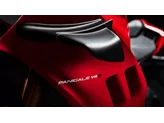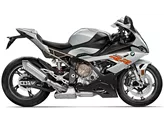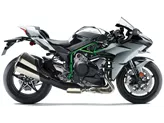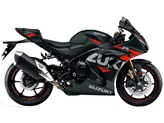Kawasaki Ninja ZX-10R 2016 vs. BMW S 1000 RR 2016

Kawasaki Ninja ZX-10R 2016

BMW S 1000 RR 2016
Overview - Kawasaki Ninja ZX-10R 2016 vs BMW S 1000 RR 2016
The Kawasaki Ninja ZX-10R 2016 and the BMW S 1000 RR 2016 are both high-performance supersport motorcycles. They have similar technical specifications, with both models featuring an inline four-cylinder engine, aluminum frame, and dual disc brakes at the front.
In terms of engine performance, the Kawasaki Ninja ZX-10R has a slightly larger displacement of 998cc compared to the BMW S 1000 RR's 999cc. However, the BMW S 1000 RR has a slightly larger bore of 80mm compared to the Kawasaki's 76mm, which may contribute to its slightly higher power output of 199 HP compared to the Kawasaki's 200.1 HP. Both bikes have a similar torque output, with the Kawasaki producing 114.3 Nm and the BMW producing 113 Nm. Both bikes also have a high compression ratio of 13.
When it comes to suspension, both bikes feature a telescopic front fork and a swingarm rear suspension. The Kawasaki Ninja ZX-10R has a unique upside-down telescopic fork, which is known for its superior performance and stability. The BMW S 1000 RR, on the other hand, has a conventional telescopic fork. Both bikes have an aluminum frame, which provides a good balance between strength and weight.

Kawasaki Ninja ZX-10R 2016
In terms of braking, both bikes feature dual disc brakes at the front. The Kawasaki Ninja ZX-10R has radial petal discs, which provide excellent stopping power and heat dissipation. The BMW S 1000 RR also has radial brakes, which offer precise control and strong braking performance.
In terms of dimensions, both bikes have a similar front tire width of 120mm and rear tire width of 190mm. They also have the same 17-inch wheel diameter. The Kawasaki Ninja ZX-10R has a slightly shorter wheelbase of 1415mm compared to the BMW S 1000 RR's 1425mm. Both bikes have a similar seat height, with the Kawasaki at 813mm and the BMW at 815mm. Both bikes also have a fuel tank capacity of around 17 liters, with the BMW having a slightly larger capacity of 17.5 liters.
In terms of strengths, the Kawasaki Ninja ZX-10R is praised for its excellent chassis geometry, high-quality chassis components, and excellent braking performance. It also has a wide range of electronic aids, which enhance its performance and safety.

BMW S 1000 RR 2016
On the other hand, the BMW S 1000 RR is known for its powerful engine, comfortable seating position, and excellent quick-shifter, which allows for smooth and effortless gear changes.
In terms of weaknesses, the Kawasaki Ninja ZX-10R is criticized for its slightly less legible cockpit display. The BMW S 1000 RR, on the other hand, is said to be a bit slower in corners compared to its competitors.
Overall, both the Kawasaki Ninja ZX-10R 2016 and the BMW S 1000 RR 2016 are high-performance supersport motorcycles with similar technical specifications. They have their own strengths and weaknesses, and the choice between the two ultimately comes down to personal preference and riding style.
Technical Specifications Kawasaki Ninja ZX-10R 2016 compared to BMW S 1000 RR 2016
Pros and Cons in comparison
Pros and Cons in comparison
Kawasaki Ninja ZX-10R 2016

A ZX-10R Ninja tem uma certa majestade, ao primeiro arranque parece muito estável, é preciso forçá-la um pouco no raio. Após algumas voltas, no entanto, este efeito transforma-se numa precisão incrível que permite uma linha precisa. O motor tornou-se agora visivelmente mais forte e faz da Kawa um pacote geral extremamente bom que pode agradar não apenas aos fãs obstinados da Kawasaki. O controle de tração no Kawa é particularmente positivo e regula muito sensivelmente. Até se pode ajustar o travão motor - por isso, não faltam certamente características electrónicas. A ZX-10R é a única superbike que já está em conformidade com a norma Euro4 em 2016!
BMW S 1000 RR 2016

A S 1000 RR é o talento universal entre as superbikes - sentamo-nos nela e sentimo-nos logo confortáveis. Embora pareça um pouco nervosa em comparação em termos de chassis e estabilidade. No entanto, ela converte isso em um manuseio agradavelmente fácil e impressiona com sua enorme potência do motor. A roda dianteira é de facto particularmente leve e tem de ser acalmada pelo amortecedor de direção. Uma caraterística incrivelmente desportiva e, ao mesmo tempo, confortável é o assistente de mudança de velocidades para aumentar e reduzir a mudança de velocidades - isto traz calma ao chassis e pode concentrar-se totalmente na condução.
Price Comparison Avarage Market Price Kawasaki Ninja ZX-10R vs BMW S 1000 RR
There are a few key differences between a Kawasaki Ninja ZX-10R 2016 and a BMW S 1000 RR 2016. In terms of price, the actual average price of a Kawasaki Ninja ZX-10R 2016 is about 39% higher. A Kawasaki Ninja ZX-10R 2016 experiences a loss of 2 040 EUR in one year and 1 990 EUR in two years of ownership. This is offset by a loss of 20 EUR and 580 EUR for a BMW S 1000 RR 2016. Compared to BMW S 1000 RR 2016 there are less Kawasaki Ninja ZX-10R 2016 bikes available on the 1000PS.de Marketplace, specifically 4 compared to 7. It takes less time to sell a BMW S 1000 RR with 69 days compared to 100 days for the Kawasaki Ninja ZX-10R. Since model year 2005 1000PS.de editors have written 51 reviews for the Kawasaki Ninja ZX-10R and 135 reviews for the BMW S 1000 RR since model year 2010. The first review for the Kawasaki Ninja ZX-10R was published on 11/01/2004 and now has more than 2 900 views. This compares to more than 4 000 views for the first review on BMW S 1000 RR published on 16/04/2008.


















